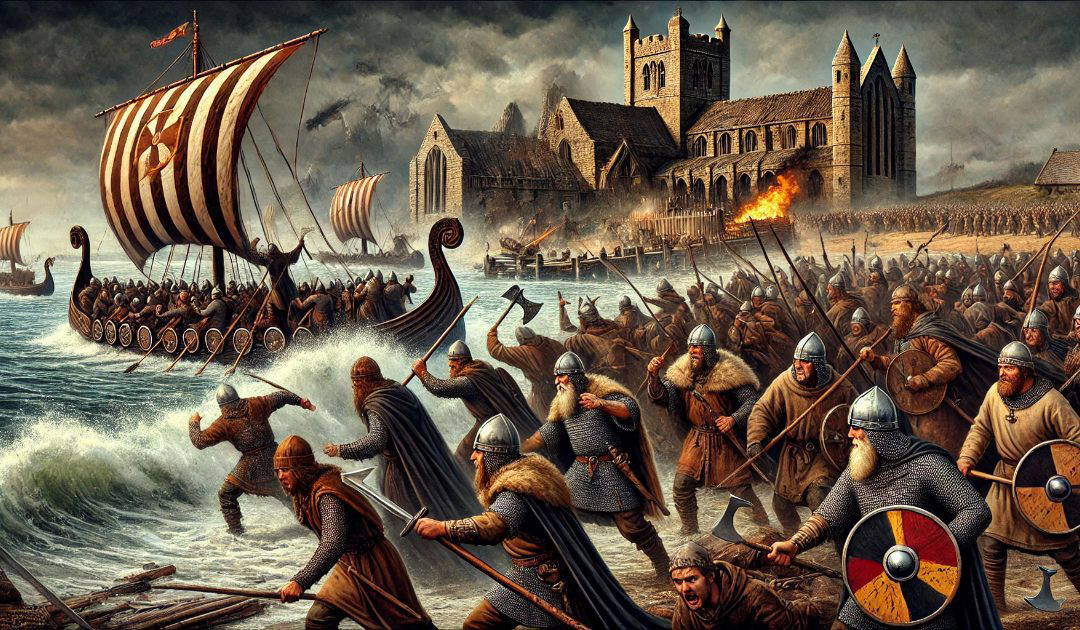Vikings raided Lindisfarne on the 8th of June, 793, the beginning of Norse activity in the British Isles. It marked a pivotal moment in European history, often cited as the dawn of the Viking Age. This brutal incursion on a small island off the northeast coast of England not only shocked the contemporary Christian world but also set the tone for centuries of Norse exploration and conquest.
Lindisfarne, also known as Holy Island, was home to a prosperous monastery established by Irish monk St. Aidan in 635. It became a major centre for Christian learning and spirituality, thanks in part to its connection to the renowned Bede and the production of the Lindisfarne Gospels, a masterpiece of Insular art. The monastery’s remote location, surrounded by the North Sea, provided isolation conducive to prayer and reflection, making it a revered site of pilgrimage.
The Vikings, seafaring warriors from Scandinavia, were known for their swift and merciless raids. On that fateful day in 793, their longships appeared on the horizon, carrying Norsemen eager for plunder. The choice of Lindisfarne as a target was strategic; its wealth was well-known, yet the island was poorly defended. The monks, unprepared for such violence, witnessed their sacred sanctuary desecrated as the Vikings looted the church of its treasures, killed many of the inhabitants, and took others as slaves.
The assault on Lindisfarne sent shockwaves throughout Christendom. Alcuin of York, a scholar at Charlemagne’s court, recorded the terror and lamented the destruction of a holy site. The raid was perceived as an attack on Christian values and a divine punishment, disrupting the peace and religious focus of the period.
The brutality of the attack marked a significant departure from previous conflicts, where violence against the church was rare. This new threat from the north introduced a period of persistent fear and instability, leading to increased fortifications and military preparedness across Europe.
The raid on Lindisfarne heralded the beginning of the Viking Age, a period spanning about 300 years. This era saw Vikings expanding far beyond Scandinavia, exploring and settling in areas across Europe, Greenland, and North America. Their impact was felt in various facets, from cultural exchanges to the alteration of political landscapes. The Viking influence is evident in the place names, language, and culture of areas they settled, particularly in Britain and Ireland.
Today, Lindisfarne remains a site of historical intrigue. Archaeological excavations have uncovered numerous artefacts, providing insights into both the Anglo-Saxon monastic life and the impact of the Viking raids. The raid, emblematic of a broader cultural clash, has captivated historians, inspiring numerous interpretations and debates about its causes and effects.
Modern tourism on Lindisfarne highlights this rich history, drawing visitors eager to explore its ancient ruins and scenic landscapes. The story of the raid is told through exhibitions at the Lindisfarne Heritage Centre, inviting reflection on the resilience of the monks who rebuilt their community in the wake of devastation.
The Viking raid on Lindisfarne stands as a turning point, marking the transition from a relatively insulated and peaceful medieval Europe to a continent shaped by Viking incursions and interactions. It underscores the dynamic nature of history, where even small islands can become the stage for events that ripple across centuries. According to Ancestry DNA I’m 10% Danish and 3% Swedish, so perhaps without the Viking Raids, I wouldn’t be quite the same.

